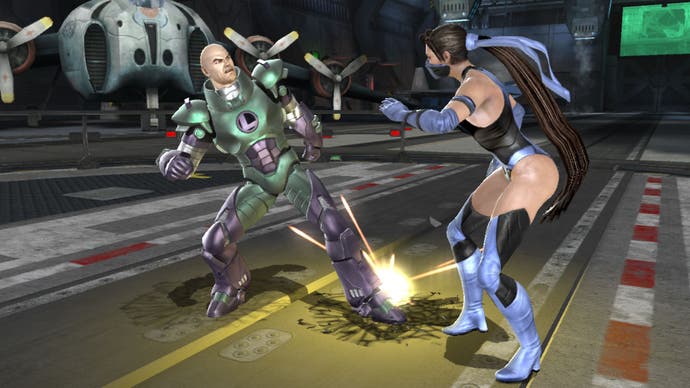Mortal Kombat vs. DC Universe
When worlds collide.
Poor old Mortal Kombat. Everything seemed to go downhill for the world's most visceral fighting series when it hit the third dimension after the release of Ultimate Mortal Kombat 3: Mortal Kombat 4 was a letdown, Deadly Alliance and Deception failed to make up for it, Armageddon was ill-conceived and the less said about the likes of Mortal Kombat: Special Forces the better.
But what was it about the early games that made Mortal Kombat so endearing? Was it gameplay that offered a viable alternative to the likes of Street Fighter II? Or was it the thrill of Sub-Zero's spine-ripping fatality, performed with the help of a tips section? No one seems to remember exactly, but with the series now languishing behind the likes of Soul Calibur and Virtua Fighter, Midway is hoping Superman, Batman and friends can rescue it from the brink in this comics vs. beat-'em-up crossover.
Crossovers sometimes work (Namco x Capcom, for instance), and the inclusion of Solid Snake and Sonic in Super Smash Bros. Brawl earlier this year proved popular. But the most obvious touchstone for MK vs. DC is of course Marvel vs. Capcom - with Tatsunoko vs. Capcom the most hotly anticipated. MK vs. DC doesn't have what it takes to dethrone Marvel vs. Capcom, but it's relatively competent.
The Story Mode opens as Raiden defeats Shao Kahn and sends him hurtling through a portal. At the same time on Earth, Superman defeats super-villain Darkseid by blasting him with his heat vision as he tries to teleport away. In a typical DC twist, neither villain is actually destroyed, and instead they merge to become Jeff Goldblum - sorry, Dark Khan.
As the universes slowly cross over, the various combatants on either side suffer from fits of rage, attacking everyone they encounter - even former friends! Everyone's power also fluctuates wildly, explaining away Liu Kang's sudden ability to fight Superman and so on. Characterisation is good, as the likes of Scorpion and The Joker behave in a way that complements one other's brand of malevolence.

Before commencing Story Mode, you're given the choice of the Mortal Kombat or DC side. Once you've pledged your allegiance, you fight through seven or eight character-specific chapters with cut-scenes in-between. These are irritatingly un-skippable and plagued with terrible voice-acting, but they're interesting enough to spur you through the two-to-three hours required. There's also the option of bicycle-kicking your way through Arcade, complete with the classically-stacked tower of conquest. The brief character endings are more or less throwaway, but dedicated MK fans might get a kick out of them.
Of course, Mortal Kombat has struggled with combat ever since it went 3D; it's reliance on simple pre-programmed dial-a-combos, basic juggles and cheap specials has left it way behind Soul Calibur's guard impacts or the sheer depth of Virtua Fighter. Yet in some ways MK vs. DC seeks to improve. Gone are the tacked-on style and weapon stances, with more emphasis on experimenting with a character's strengths, developing combos through manipulation of the in-game physics. Oddly, however, you have to use the analogue stick for 3D movement and sidestepping, and the d-pad for 2D movement and jumping, while holding the left trigger reverses this. Bizarre. At least include a few options for customising it.

MK vs. DC adds further pain to the onslaught with Klose Kombat, Free-Fall Kombat and Test Your Might. Klose Kombat is initiated when you grab your opponent, giving you about five seconds to target one of four areas with the face buttons - crotch kicks, arm breaks and haymakers. Should your opponent match your button press they'll perform a Kounter move and escape further damage. Free-Fall Kombat works similarly and occurs when you hurl your opponent off one of the multi-tiered arenas. As both combatants plummet to the depths below, attacks through the face buttons are active, and should your Super gauge rise high enough you'll be able to execute your character's Free-Fall Super, with a chance of dishing out the maximum damage possible. A successful Kounter here switches offensive and defensive positions, striking a good balance between risk and reward.


